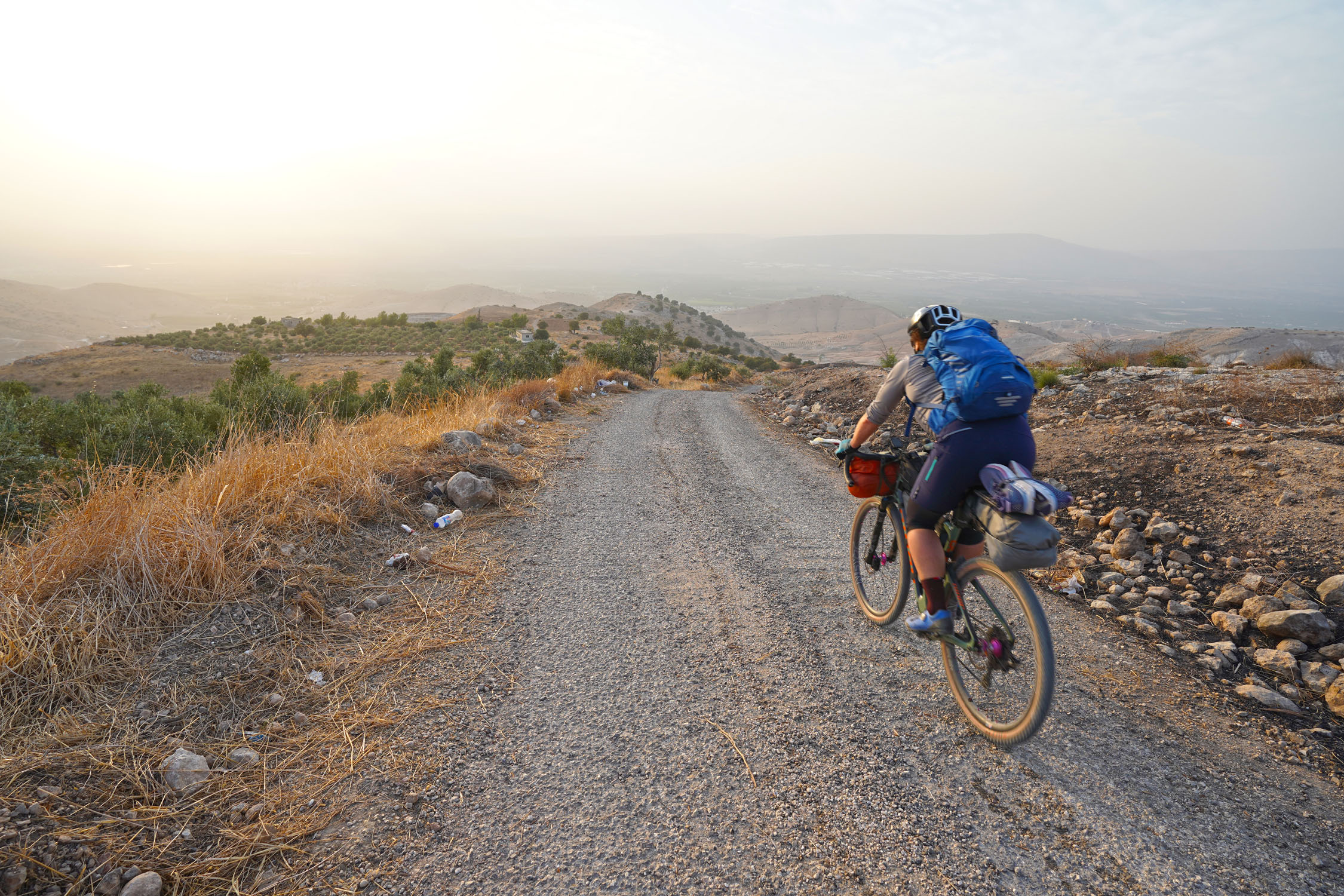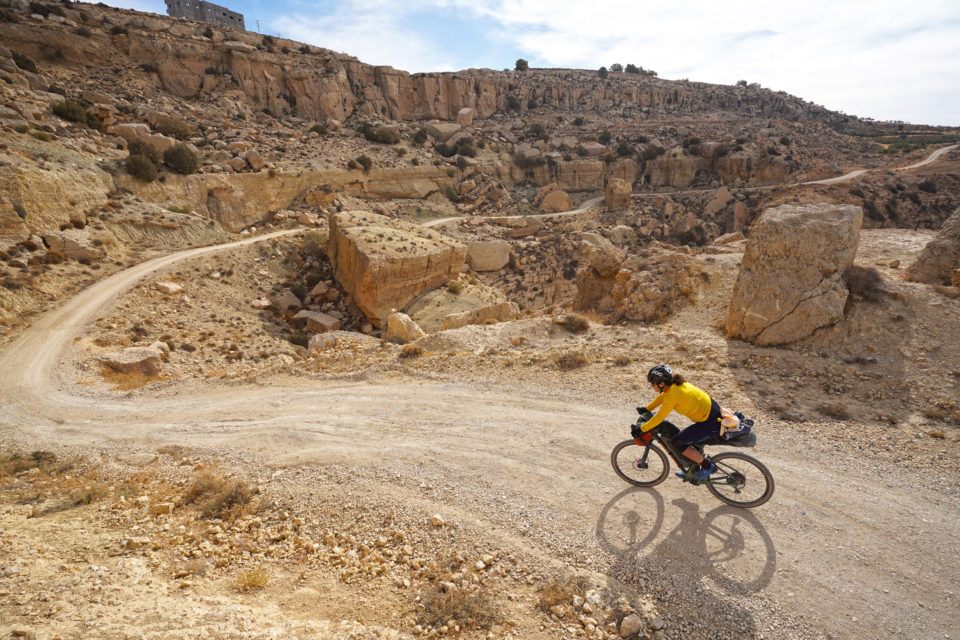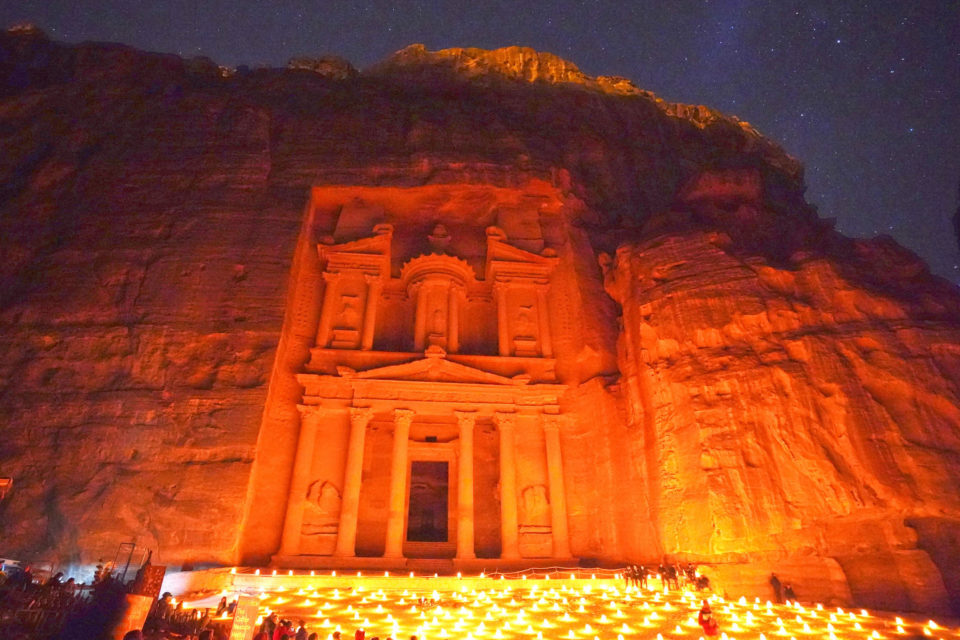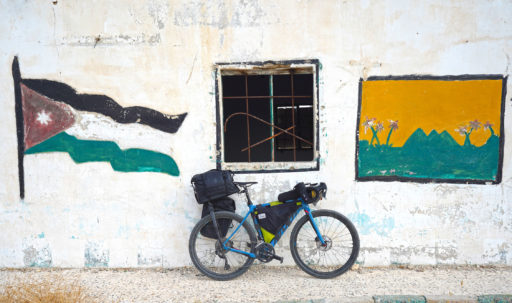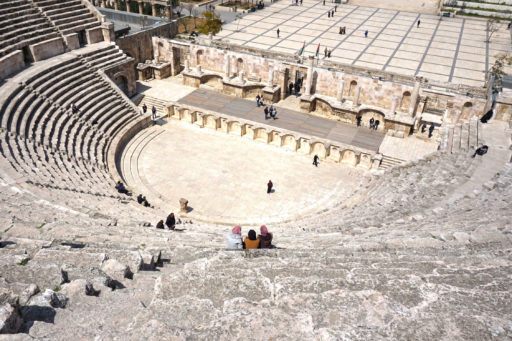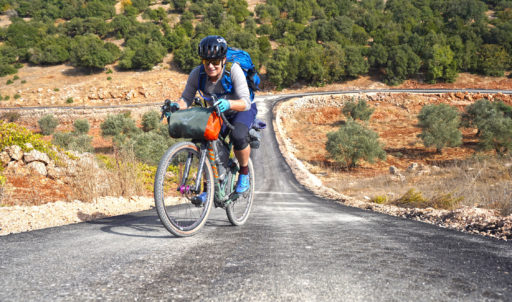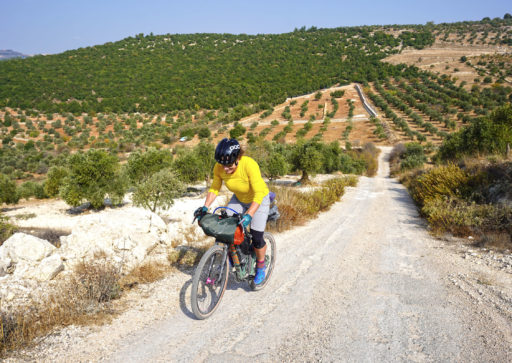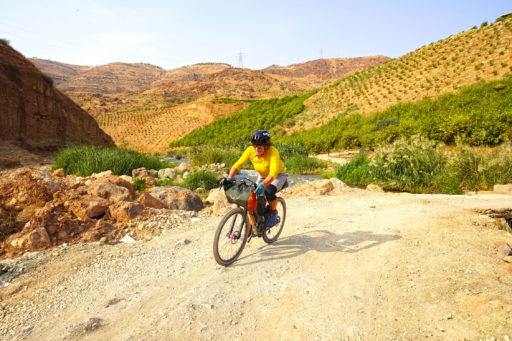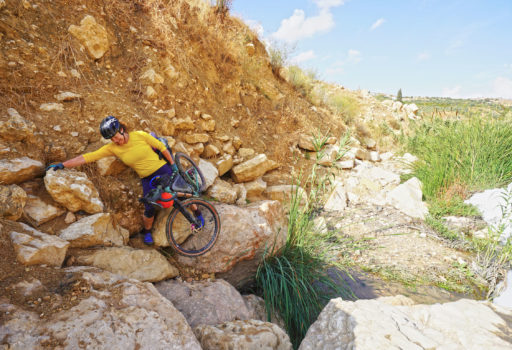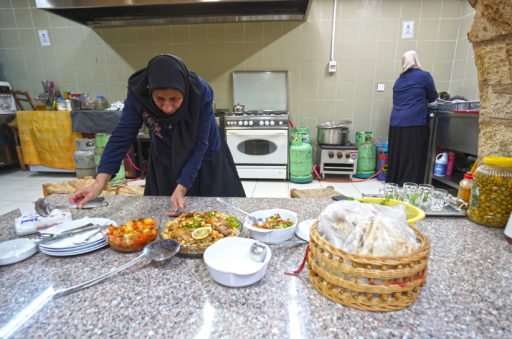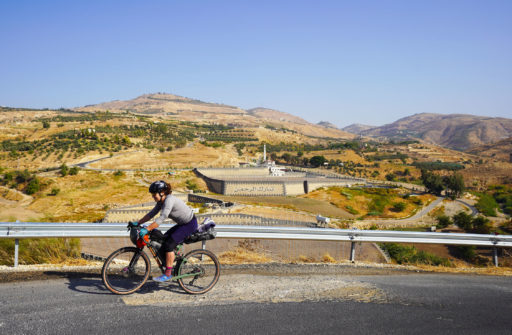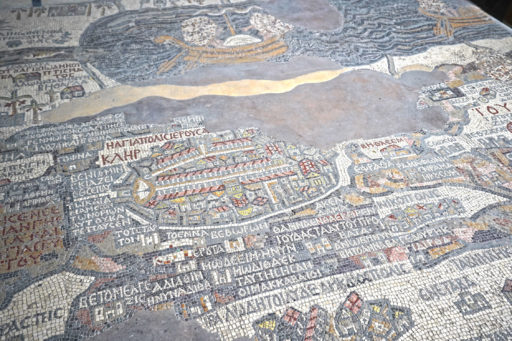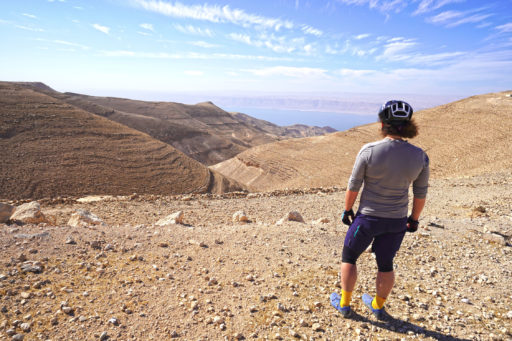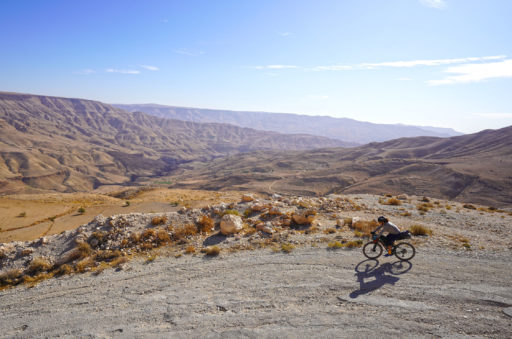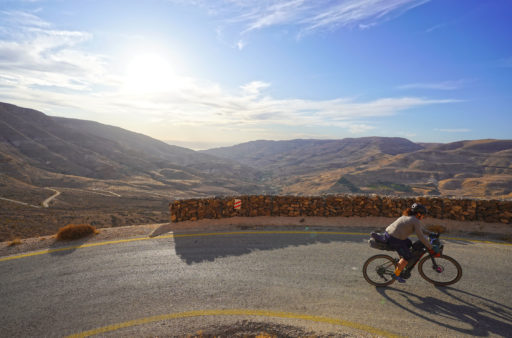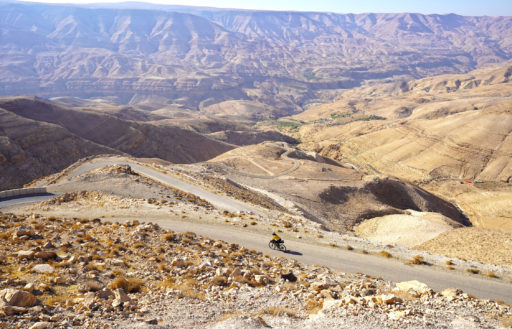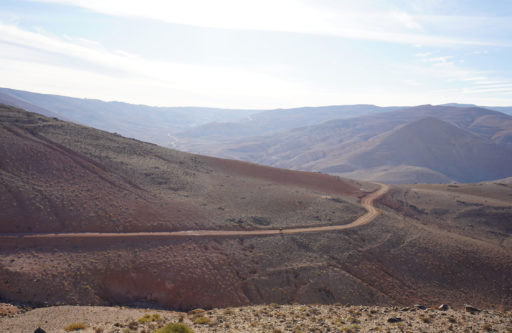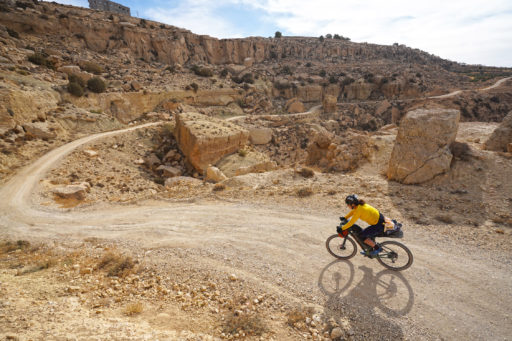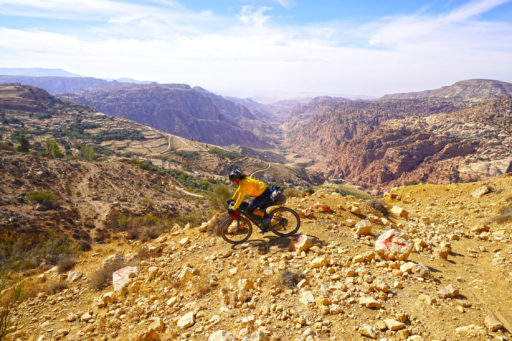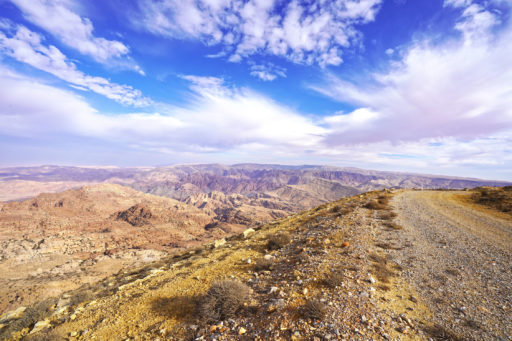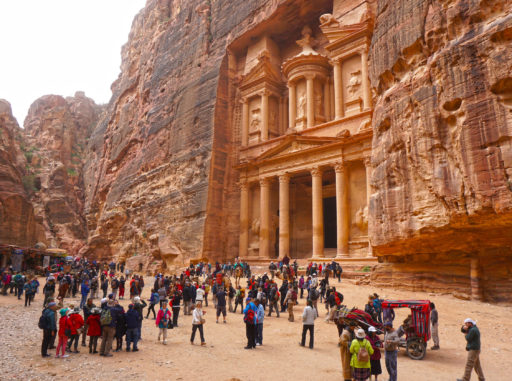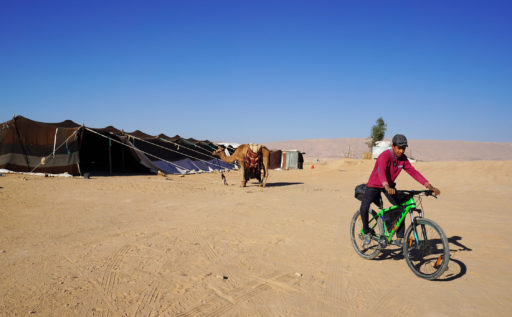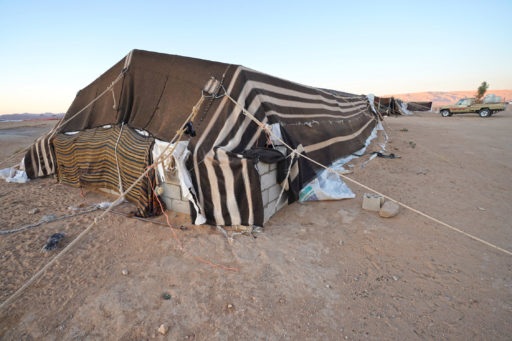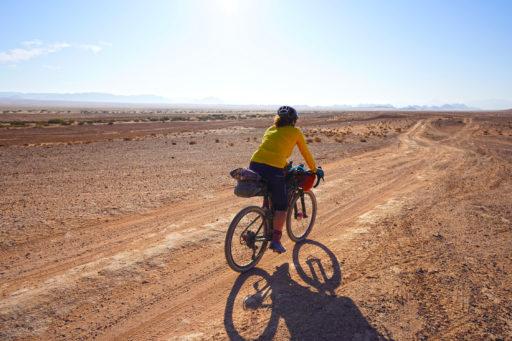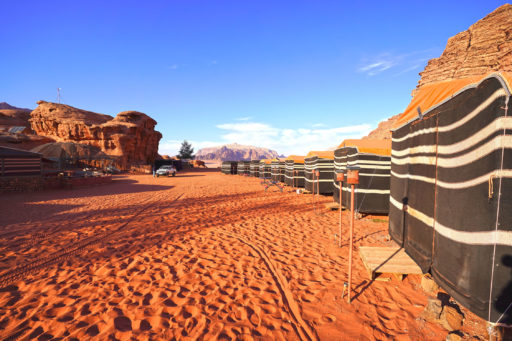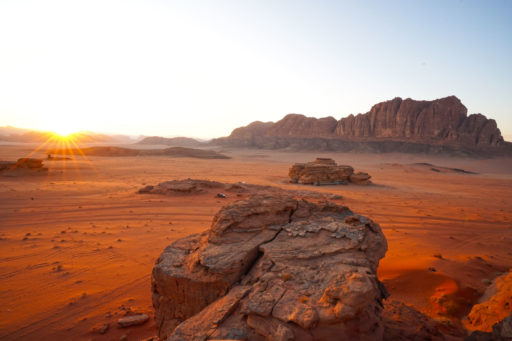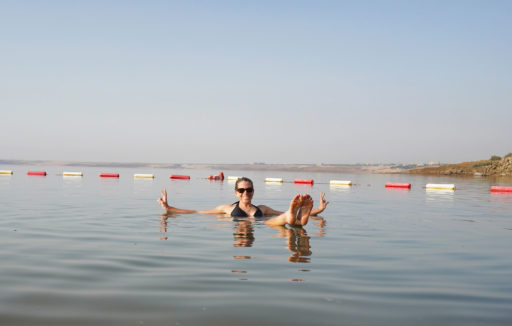The Jordan Bike Trail
Distance
456 Mi.
(734 KM)Days
12
% Unpaved
60%
% Singletrack
5%
% Rideable (time)
85%
Total Ascent
54,964'
(16,753 M)High Point
5,573'
(1,699 M)Difficulty (1-10)
6?
- 8Climbing Scale Strenuous121 FT/MI (23 M/KM)
- -Technical Difficulty
- -Physical Demand
- -Resupply & Logistics
Contributed By

Amy Jurries
Guest Contributor
Amy is an outdoor and adventure travel writer based in San Francisco. When not exploring far off places on her bike, she can be found hanging off frozen waterfalls or backpacking with her dog, Lola. Follow more of Amy’s adventures on Instagram @thegearcaster
While Instagram may lead you to believe otherwise, Jordan is so much more than Petra, the Dead Sea, and Wadi Rum. Millennia of history and an abundance of natural wonders add to the draw of this Maine-sized Middle Eastern country. Throw in some legendary Jordanian hospitality and you have the makings of a truly memorable adventure.
The Jordan Bike Trail is a 455-mile (730-kilometer) point-to-point bike route that travels the length of the country from north to south, passing through the main historical and natural wonders along the way. The route is divided into three distinct sections—Northern, Central, Southern—each broken down into four separate day-long stages.
The Northern section is characterized by steep, rocky hills lined with row after row of olive groves where the smell of freshly pressed olives fills the air and goats roam free. Dropping down into the Jordan Valley, the fragrant bloom of citrus trees perfumes the air as you roll through lush farmland. While less than 1% of Jordan is forested, you’ll find some of the last endemic oak forests in the Middle East in the northwest corner of the country. Riding through the forests of the Ajloun Forest Reserve, one of five natural reserves in the country, you’ll be forgiven for thinking you might be on the Mediterranean, surrounded by oak, pine, wild pistachio, and wild strawberry trees. Throughout the north, Roman ruins pepper the landscape, with the Decapolis ruins of Umm Qais and Pella marking the eastern frontier of the Roman Empire, and medieval castles still stand sentry over their ancient territories.
The Central section is highly dramatic and challenging, with several massive canyons (or wadi) crossing the Dead Sea area, many with chunky descents and thousands of feet of elevation loss and subsequent gain. In this area, substantial rains can make for muddy, unrideable conditions and create the all-too-real risk of killer flash floods—be sure to check the weather before you set off. Parts of the trail have washed away and a bit of route finding is required. You’ll continually struggle to keep your eye on the trail as you pass through the dramatic landscapes of Dana and Wadi Mujib, with their Neapolitan-colored layers of limestone, sandstone, and granite worn away by the weather of time.
Along the Southern section, the Jordanian Highlands slowly descend into the southern desert, replacing mountains with deep sand to slow your progress. Expect to spend much time pushing your bike, just when you thought you would finally get a full day of riding in. It may be all downhill to Aqaba but don’t let that fool you—you have some tough days ahead. For all this effort, however, you are rewarded with awe-inspiring scenery and some of the main historical and natural wonders of the country, including Petra and Wadi Rum, before finishing at the azure waters of the Red Sea for a well-deserved rest and recovery.
As a visitor to Jordan, expect to hear cries of “Welcome to Jordan!” by everyone you meet, be offered sweet tea hundreds of times a day, and even share a home-cooked meal with a family. Pack your bags each day with freshly baked bread, fresh-fried falafel, sweet halva, briny olives, and power up on cardamom-spiced coffee made fresh as you wait.
Route Development
Matt Loveland, founder of Experience Jordan Adventures, is the mastermind behind The Jordan Bike Trail. Matt and his team at the adventure tour company worked together to scout the route and develop resources along the trail, generating GPX tracks, a website, and a detailed guidebook in the process.
Route Difficulty: We awarded The Jordan Bike Trail a 6 out of 10 in terms of difficulty. This rating is based largely on the amount of climbing involved along the route and the steepness of grades. Finishing the ride in 12 days requires on average 6,000 feet of climbing per day and plenty of hike-a-bike. Resupply points are frequent enough that you don’t need more than a day’s worth of water and food. However many of these resupply points are off trail, adding extra mileage to your day.
Submit Route Alert
As the leading creator and publisher of bikepacking routes, BIKEPACKING.com endeavors to maintain, improve, and advocate for our growing network of bikepacking routes all over the world. As such, our editorial team, route creators, and Route Stewards serve as mediators for route improvements and opportunities for connectivity, conservation, and community growth around these routes. To facilitate these efforts, we rely on our Bikepacking Collective and the greater bikepacking community to call attention to critical issues and opportunities that are discovered while riding these routes. If you have a vital issue or opportunity regarding this route that pertains to one of the subjects below, please let us know:
Highlights
Must Know
Camping
Food/H2O
Trail Notes
Resources
- Historical wonders including the Decapolis ruins of Umm Qais and Pella; Greco-Roman ruins in Jerash and Amman; Crusader castles of Shobak, Karak, and Ajloun; Biblical sites of Mt. Nebo and Madaba; and the UNESCO World Heritage Site of Petra.
- The magical red desert of Wadi Rum and its sandstone and granite mountains floating in an endless sea of sand. T.E. Lawrence, better known as Lawrence of Arabia, perfectly described it as, “Vast, echoing, and God-like,“ in his autobiography, Seven Pillars of Wisdom.
- Legendary Jordanian Hospitality. You won’t make it far without hearing “Welcome to Jordan” and being invited to share some sweet tea.
- Riding up and down the deep canyons that dissect the high plateau dominating the eastern half of the country. These canyons (known as wadis) make for beautiful backdrops, but also hard riding.
- Floating in the briny waters of the Dead Sea. While not on the route, you can easily take a side trip or visit on your return to Amman.
- Tasting beer at Carakale, Jordan’s first and only microbrewery, located in the Christian town of Fuheis.
- When to go: With comfortable temperatures and little chance of rain, spring (March-April) or fall (October-December) are the best seasons to ride The Jordan Bike Trail. In the spring, you’re likely to see wildflowers in bloom in the north. Be sure to avoid riding during Ramadan (the dates change yearly), as most stores and restaurants will be closed and it’s forbidden to eat or drink in front of anyone fasting.
- Direction: The route is designed to be ridden north to south, with more gradual ascents on firmer terrain.
- Transport: It’s easy to arrange a driver to take you to the start in Umm Qais or almost anywhere along the trail that is accessible by road. At the finish, you can fly out of Aqaba or get a driver to take you back to Amman.
- Dangers and Annoyances: Jordan itself is an extremely safe and welcoming country. As it is a predominantly Muslim country, you should plan to dress conservatively (i.e., no Lycra). As women, we wore loose clothing that covered our arms and dropped below our knees. I would not recommend that a woman ride solo. Even as two women we ran into some harassment from teenage boys (nothing serious) and kids throwing rocks at us. Dogs are a constant annoyance, too. Wherever there are goats or Bedouin camps, expect dogs to follow, some armed with huge nail collars for dramatic effect.
- Visa: A tourist visa is required for most nationalities. I recommend buying the Jordan Pass, which in addition to an entry visa, gives you free access to tourist sites like Petra.
- Language: English is not widely spoken outside of Amman or the major tourist spots like Petra and the Dead Sea. We found Google Translate helpful for daily conversation. Learn the Arabic word “esht,” which loosely translates to “May you live long,” and is a polite way to go above and beyond the standard “La, shukran” to decline the numerous offers of tea on a daily basis. Place your right hand over your heart and politely make your excuses.
- Cash is King: Outside of the major cities, you will have to pay cash for everything.
- Wild camping is not really a thing in Jordan, but it can be done with some creativity. Camping in any of the Reserves, however, is strictly forbidden. We found ourselves surrounded by curious people every time we stopped, and after a few unpleasant encounters with teenage boys, it was obvious that as women, it was not viable to camp.
- Experience Jordan Adventures went to great lengths to set up homestays, Bedouin tents, Women’s Cooperatives, and other accommodations each night along the route, and these ended up producing some of our best experiences on the trail. If you can afford it (expect to pay anywhere from 20-40 JD per night), it’s recommended for cyclists to stay in these accommodations. This way, you can support the local economy and even save weight in gear.
- While there are a few springs along the route, water sources are rare—it’s not recommended to drink out of canyon rivers due to farm run off. Basically, you are going to be buying your water each day. Resupply stops are frequent, apart from a couple of days with no services en route, but you never need to carry more than a day’s worth of water or food. In most towns you can find fresh bread, falafel, small stores with the basics, and coffee to keep you going.
- Be sure to stop at Carakale Brewery outside of Fuheis for some food (supposedly the best pizza in Jordan) and beer tasting—one of your only opportunities for alcohol along the trail.
- Rideability: There are quite a few hike-a-bike sections as either the trail is too steep for a loaded bike (i.e., sustained 22%+ grade), deep sand for miles in the southern desert, or the trail is washed away due to flash flooding in the wadis. Pretty much every day apart from one or two requires some form of hike-a-bike.
- Be sure to make time for socializing. You will be stopped multiple times a day by people who are curious to know where you are from, why you’re riding this or that crazy road on a bike, wanting to take selfies, offering tea, hoping to practice English, you name it. For me, this was one of the highlights of the experience and should not be passed over just to make up more mileage each day.
- You absolutely can ride this route on a gravel bike—we rode a Pivot Vault and Niner Magic Carpet Ride with 47mm tires without incident. Just be ready to push your bike for miles through the deep sand of the southern desert. That being said, some of the wadi descents are long (thousands of feet of elevation loss) on chunky, loose terrain where front suspension would make your life much easier and more comfortable.
- I would recommend going tubeless as goat heads and broken glass abound, and you’ll be able to run a lower tire pressure on the sand.
- Bring absolutely everything and anything you can think of in terms of bike repair and maintenance on the trail, as outside of Amman, you will not find a single bike shop or anyone knowledgeable to help with repairs. In Amman, Cycling Jordan is good for last minute bike fixes and supplies.
Additional Resources
- The Jordan Bike Trail website
- Amy Bikes Jordan – my day-by-day account of life on the trail
Terms of Use: As with each bikepacking route guide published on BIKEPACKING.com, should you choose to cycle this route, do so at your own risk. Prior to setting out check current local weather, conditions, and land/road closures. While riding, obey all public and private land use restrictions and rules, carry proper safety and navigational equipment, and of course, follow the #leavenotrace guidelines. The information found herein is simply a planning resource to be used as a point of inspiration in conjunction with your own due-diligence. In spite of the fact that this route, associated GPS track (GPX and maps), and all route guidelines were prepared under diligent research by the specified contributor and/or contributors, the accuracy of such and judgement of the author is not guaranteed. BIKEPACKING.com LLC, its partners, associates, and contributors are in no way liable for personal injury, damage to personal property, or any other such situation that might happen to individual riders cycling or following this route.
FILED IN (CATEGORIES & TAGS)
The Middle East
Please keep the conversation civil, constructive, and inclusive, or your comment will be removed.







